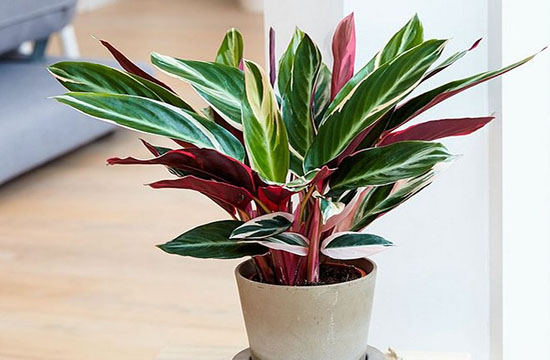
Stromanthe belongs to the Marantaceae family. Under natural conditions, it grows in the tropics of America.
Stromanta is one of the most spectacular indoor plants, which surprises not only with its beauty, but also with its difficult character. The tropical beauty is demanding in care, so it should only be bred by those who can create all the necessary conditions for it.
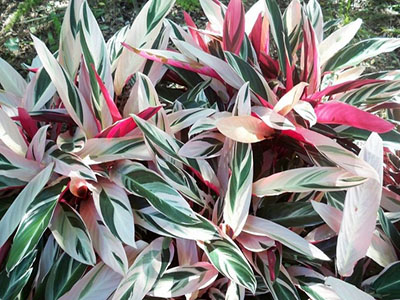
Due to its unusual coloring, this culture stands out against the background of other indoor plants. Therefore, even despite the difficult care, for flower growers she is a welcome guest.

Types and varieties of stromantha
Perennial herbaceous plant, reaching 40 – 100 cm in height, with low, often completely reduced multi-branched shoots.
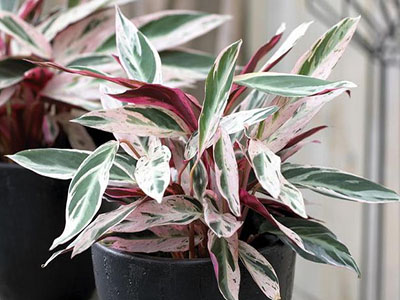
Like all representatives of the arrowroot family (calathea, arrowroot, ktenante), the stromanth flower, as seen in the photo above, has beautiful rather large leaves.
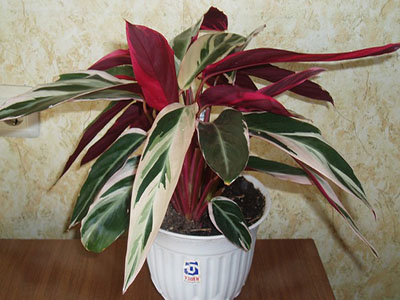
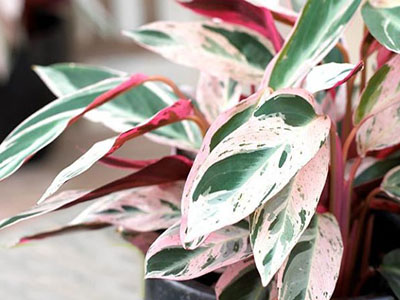

Leaf plates are large, obovate, oval-lanceolate, up to 35 cm in length, dark green or olive hue.
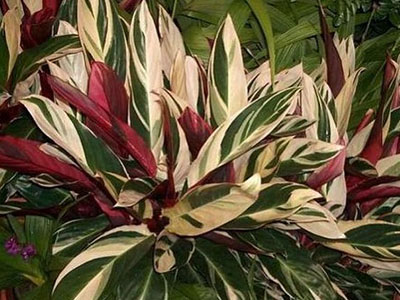
On the surface of the leaves there is a variegated pattern in the form of stripes, strokes and spots of white and cream shades, which gives the plant an elegant festive look.
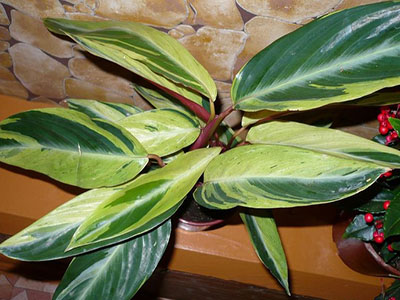
The underside of the leaves is purple. During the day, the leaves are always turned towards the sun, and at night they stretch upwards, which is a feature of this flower. Some types of stromante form a second tier of leaves.
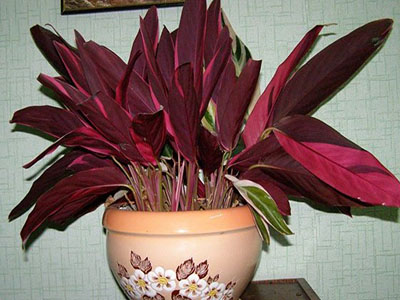
It blooms in summer, throwing out a long peduncle with small cup-shaped flowers of red, white and yellowish hue. The flowers exude a strong, pleasant aroma.
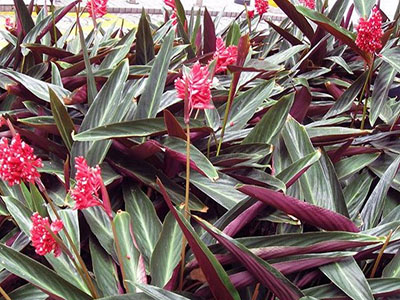
Another feature of the stromantha is that during the flowering period, the leaves lose their attractiveness, the bushes become loose and begin to fall apart. The plant itself slows down its growth or completely stops growing.

After flowering, it does not recover well, so it is not surprising that flower growers refuse to bloom in favor of obtaining decorative foliage.

In floriculture, the most commonly used species is pleasant stromante (U. amabilis) . She has oval leaves, 10-20 cm long, 4-5 cm wide, light green with a dark green pattern, the underside is grayish green.
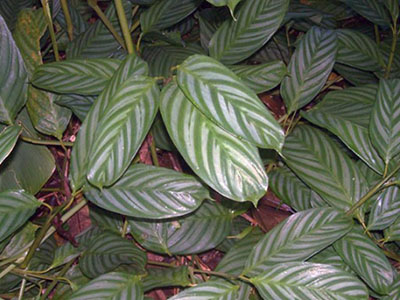
A variety of stromanths – yellow (jacquinii or lutea) has large dimensions, reaching up to 2 m in height. For this reason, it is extremely rare in apartments. It is mainly bred in greenhouses and winter gardens. The leaves are oval, dark green, up to 35 cm long. The flowers are small, bright yellow.
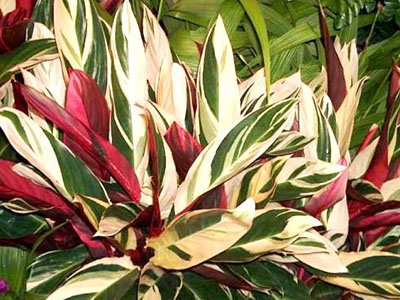
Blood red stromanthus (sanguinea). The homeland of this species is Brazil, where the plant grows in natural conditions. Flower height – 30 – 50 cm. The leaves are oval, arrow-shaped, pointed at the end, up to 40 cm long and up to 12 cm wide, light green, shiny, with a V-shaped pattern, red or purple below.
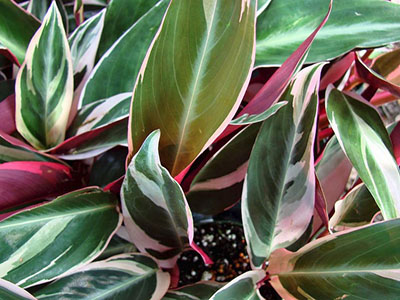
The flowers are small, inconspicuous, collected in compact inflorescences. This plant is considered highly decorative and is often found in apartments and offices.
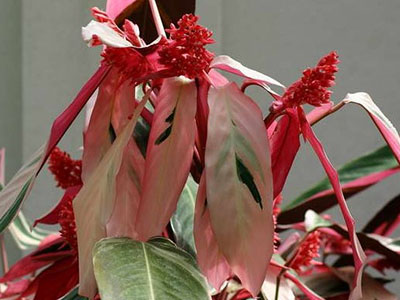
Below are photos of stromantha species and some of its varieties, which are definitely worth a look for those who are not yet familiar with a beautiful indoor flower.
The most successful varieties of this species:
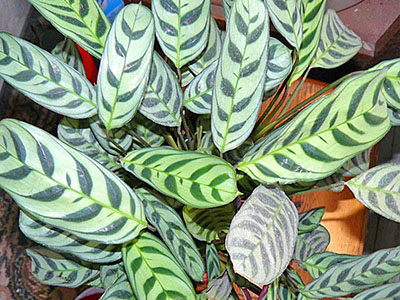
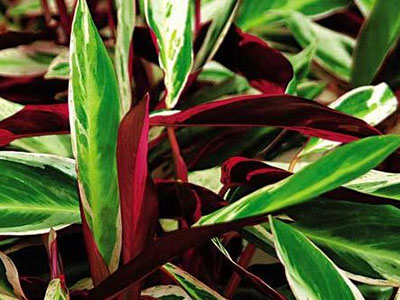

Stromanta “Tricolor” – distinguished by long, pointed leaves, the surface of which is dark green, with light green, pinkish and white stains scattered over it. The underside of the leaf plates is burgundy.

Stromanta “Maroon” – a variety with dark green bright leaves and a light green stripe running through the center of each leaf plate. The underside of the leaves are purple.
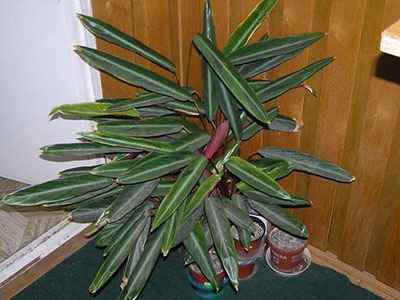
Stromanta “Hortikolor” – a variety with an unusual coloring of the leaves. Their surface consists of a combination of olive, yellow and light green shades. The underside of the leaf is dark red.
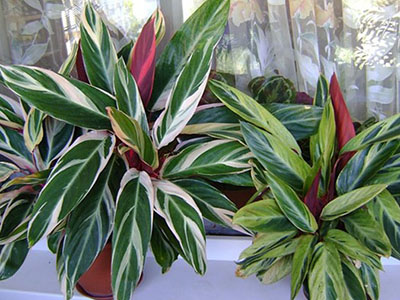
For cultivation in an apartment, it is recommended that the Stripe Star stromanta variety, which has a modest size, bright dark green leaf plates with a pattern applied to them in the form of white asymmetric stripes extending from the central vein. The underside of the leaf is burgundy.
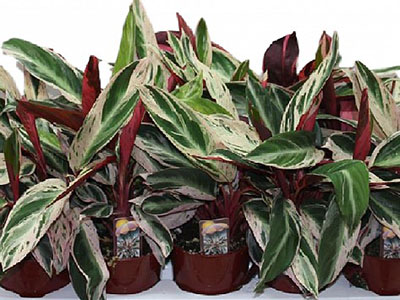
How to properly care for a stromanta flower (with video)
In order for the home flowers of the stromanth to grow well, they must be cared for regularly, taking into account all its high requirements.
Location. Despite the fact that this culture is warm and light-loving, it cannot be said that it urgently needs bright sunlight. On the contrary, direct sunlight harms the plant, causing the leaves to burn, as a result of which they curl and do not recover well. However, in the shade, the flower also grows poorly. For the full development of a houseplant, stromanthas need bright diffused light, in summer – the rays of the morning sun. It can also grow in partial shade. If there is not enough light in the apartment for this crop, it is recommended to use additional lighting. The blood-red stromanta needs plenty of sunlight; in partial shade, its multi-colored leaves lose their characteristic color. This is important to take into account in the winter, trying to compensate for the seasonal lack of light with artificial lighting.
Temperature. When growing stromanth flowers, flower growers know that care should be taken in a warm room with a stable air temperature, since this flower is capricious, loving greenhouse conditions. He does not tolerate a sharp change in temperature, especially their strong decrease. In the warm season, temperatures can vary from 18 to 30 degrees and above. In winter, the temperature of the content is at least 10 ° C, but the humidity of the air, as in summer, should be high.
You should not keep this culture near heaters, air conditioners, near windows, walls and in places where the temperature can change frequently. It must be protected from drafts. In the summer it can be taken out into the air.
Watering. When caring for a stromant at home, it is important to choose the optimal watering, starting from the state of the earthy coma and preventing it from drying out, as well as waterlogging. It is better to spray the plant once again than water it. The soil in the pot should always be moderately moist. If you are going to water a flower, you need to check the condition of the topsoil. If it’s dry, it’s time to water. In winter, the frequency of watering is reduced, since the evaporation of moisture is not as intense as in the warm season. Another feature of moistening the stromanth is that the remaining water must be drained from the pan in order to avoid rotting of the root system.
Caring for a stromanth flower at home includes the task of ensuring optimal indoor air humidity, since when it decreases, it begins to suffer, which immediately affects its condition. The tips of already formed leaves dry out, and new leaves will be small and inconspicuous. The most optimal humidity is 60 – 70% and above. You can humidify dry air by installing special appliances in the room or by placing the pot on a pallet with wet moss, pebbles and expanded clay so that the bottom does not touch the water. It is useful to carry out daily spraying of the plant using a spray gun with fine nozzles to evenly distribute water on the flower. Water for irrigation and spraying should be soft and warm.
Topdressing. Despite its whimsicalness, the stromanta plant does not need a large amount of top dressing during the care process. On the contrary, excess fertilizer causes problems with her health.
During the growth period, from April to September, fertilizing with flower fertilizers is carried out. It is enough to fertilize 1 time in 2 weeks. For this culture, fertilizers of decorative leafy plants, as well as mineral fertilizers for indoor flowers, are suitable. Ideal fertilizer for arrowroot.
Pruning. To maintain attractiveness, flower stalks that appear periodically are removed, since flowering negatively affects the beauty of stromanth leaves.
Substrate and transplant. For a capricious flower, light loose mixtures are suitable, for example, a substrate of leafy and soddy soil, peat, humus and sand (1:1:1:1:1). You can use ready-made soil mixtures for arrowroot, palm trees or rhododendrons.
A flower transplant is carried out annually, regardless of how much it has grown. This work is carried out with the onset of warm days in April – May. The stromant is transplanted into a container slightly larger than the previous one, laying a high layer of drainage on the bottom of the new container. The transplant is carried out very carefully, trying not to damage the roots and without destroying the earthen ball. The flower is buried in fresh soil, after which it is watered and removed to a permanent place. Pots for this plant need to choose wide, but not deep. In a deep container, there is a high probability of violation of the moisture regime and rotting of the roots.
More information about the proper cultivation of stromanths will tell the video, which can be viewed below on our page.
Methods of propagation of stromanta
The culture is propagated by seeds, dividing the bush and apical cuttings. The seed method is used very rarely, as it requires a lot of effort and takes a lot of time.
Much more often, the reproduction of the stromanth is carried out by dividing the bush. This work must be carried out during the transplant. An overgrown adult plant is removed from the pot and divided into parts. The resulting parts of the flower are planted in separate containers, watered with settled water at room temperature and cleaned in a well-lit, warm place, but away from direct sunlight. From above, the delenki are covered with a film or a glass jar. The next watering will be required after the earthen coma has completely dried. After about a month, new leaves will appear.
You can propagate the stromanth indoor flower with apical cuttings in spring with the onset of warm days or in summer. It is necessary to cut off the upper part of the stem about 9 cm in size, so that 2 – 3 leaves remain on it. Cuttings cut below the place where the leaf is attached to the stem should be placed in water and covered with a plastic bag, and then removed to a warm, bright place. In conditions of heat and high humidity, the stalk will take root in 1.5 months. After that, it can be planted in a pot with a substrate.
Why do stromants curl and dry the tips of the leaves: diseases and pests
The stromanta flower immediately reacts to any uncomfortable conditions for the condition by worsening its appearance. You can judge what causes discomfort in a capricious beauty by the state of her leaves.
In order to avoid problems with her health and decorativeness, you need to adhere to proper care and quickly eliminate the possible causes of her diseases. Then you won’t have to restore the stromant after an illness, and doing this is often very difficult. So, what difficulties may arise when breeding a flower, how to prevent them and how to deal with them, will be discussed further.
Most often, the diseases of this culture are negatively reflected in its beautiful leaves. They can dry, turn yellow, fade, lose their bright color. This is due to improper plant conditions.
The most common growing problem is that the tips of the leaves dry on the stromanthus. If they also turn yellow at the same time, most likely the flower is in direct sunlight. In this case, you need to remove the pot to another place at the time when direct rays fall on it, or shade it. If the tips of the leaves dry and the flower stops growing at the same time, dry air may be to blame, especially during the heating season. In some cases, the cause of the problem is a spider mite. You should carefully examine the flower for the presence of a pest, if it is not found, you need to take measures to humidify the air in the room.
Another reason why the leaves of the stromanthus dry is damage by pests: mealybug, scale insect, thrips or whitefly. The Actellik drug will help to destroy pests: 1 ampoule is diluted in 1 liter of water, the plant is sprayed with the resulting solution.
In stromanths, the leaves are twisted into tubules and covered with spots – the result of insufficient watering. It is necessary to moisten the flower more often, otherwise the leaves will gradually become translucent and dry, and it will lose its decorative qualities. If the leaves are curled and the petioles are bent in different directions, this indicates that the temperature in the room is low for the culture, or it indicates that the soil in the pot dries out quickly and the plant does not have enough moisture.
It also happens that a yellow or brown border forms along the edge of the leaf, which means that the plant lacks nutrients. You need to feed more often.
By getting acquainted with the information on how to care for the stromanth flower, the grower will be able to avoid many unnecessary problems when growing it and enjoy its fresh and healthy appearance.







